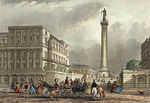Global Warming Policy Foundation
The Global Warming Policy Foundation (GWPF) is a charitable organization in the United Kingdom whose stated aims are to challenge what it calls "extremely damaging and harmful policies" envisaged by governments to mitigate anthropogenic global warming. The GWPF, and some of its prominent members individually, have been characterized as practising and promoting climate change denial.In 2014, when the Charity Commission ruled that the GWPF had breached rules on impartiality, a non-charitable organisation called the "Global Warming Policy Forum" was created to do lobbying that a charity could not. The GWPF website carries an array of articles sceptical of the scientific consensus of anthropogenic global warming and its impacts.
Excerpt from the Wikipedia article Global Warming Policy Foundation (License: CC BY-SA 3.0, Authors).Global Warming Policy Foundation
Waterloo Place, City of Westminster Covent Garden
Geographical coordinates (GPS) Address Nearby Places Show on map
Geographical coordinates (GPS)
| Latitude | Longitude |
|---|---|
| N 51.506388888889 ° | E -0.13194444444444 ° |
Address
King Edward VII
Waterloo Place
SW1Y 5ER City of Westminster, Covent Garden
England, United Kingdom
Open on Google Maps










